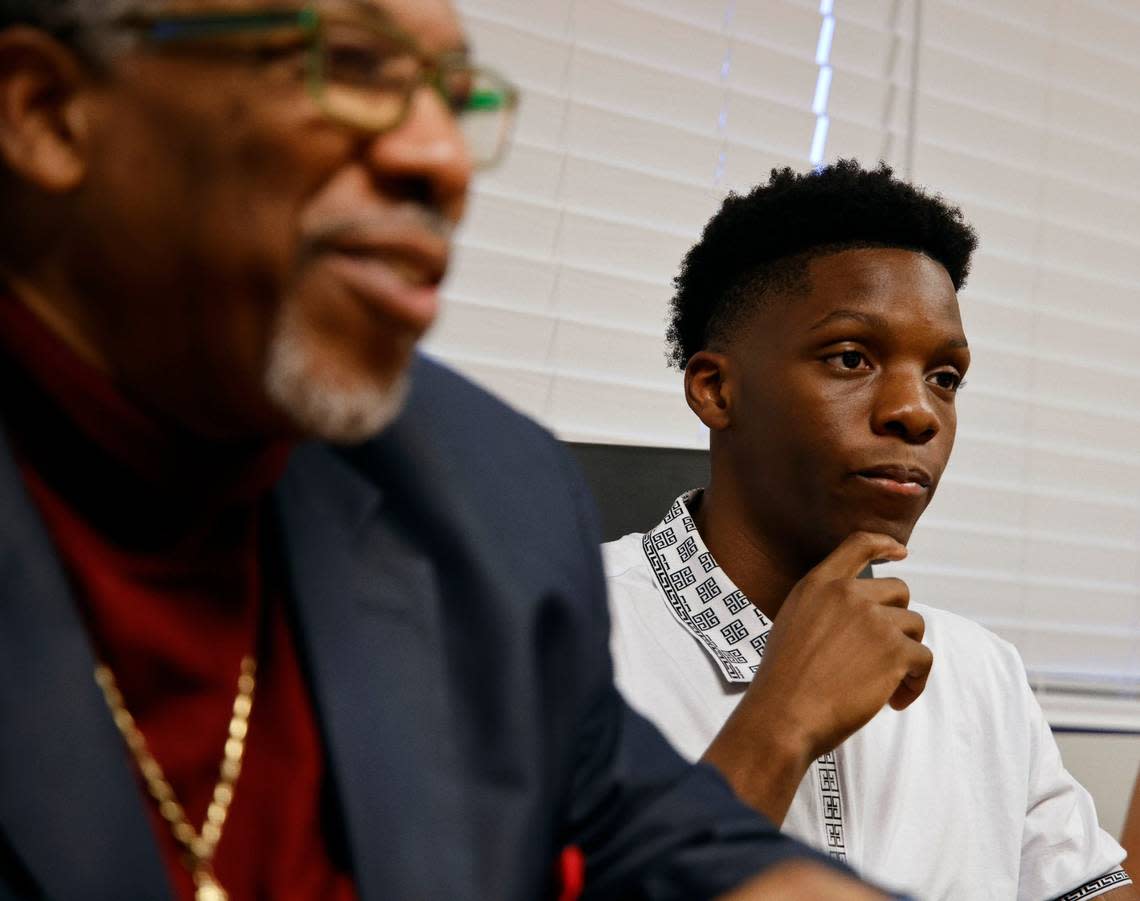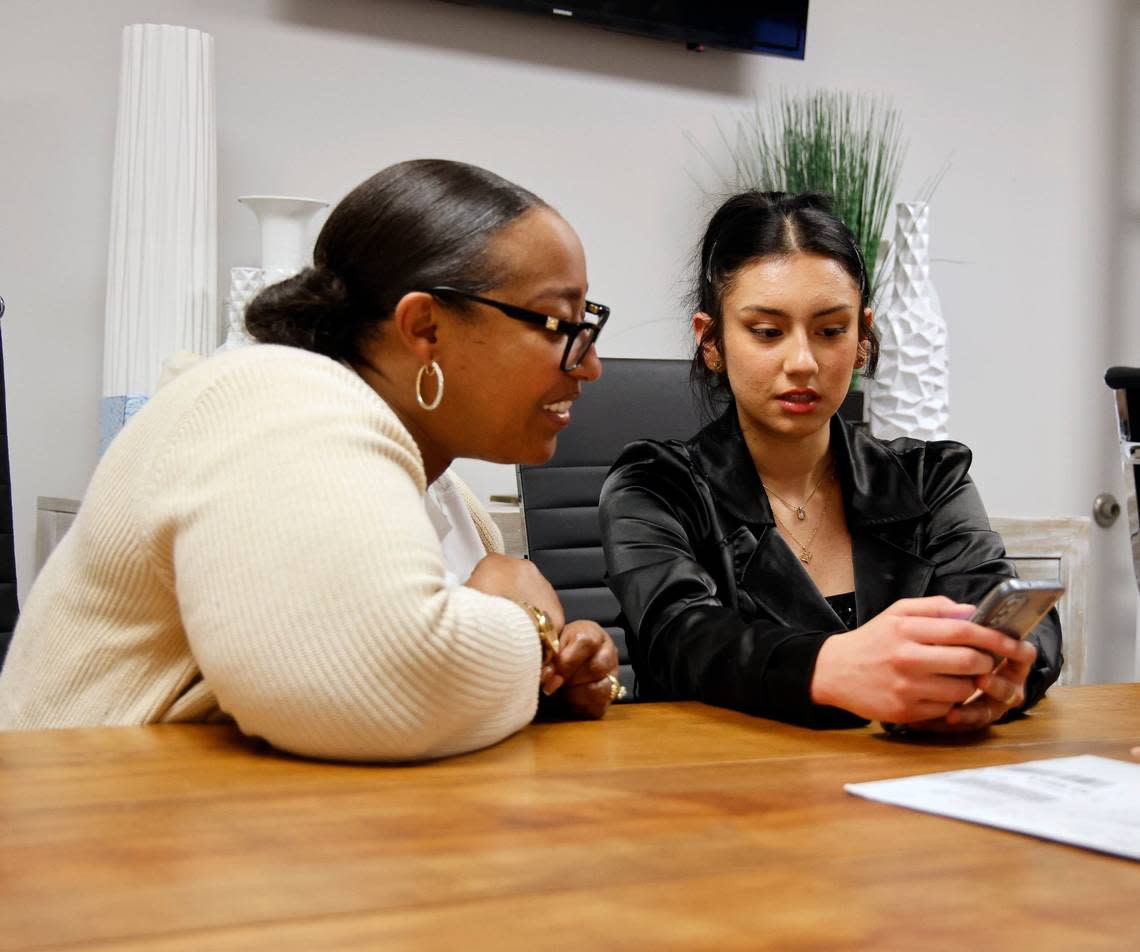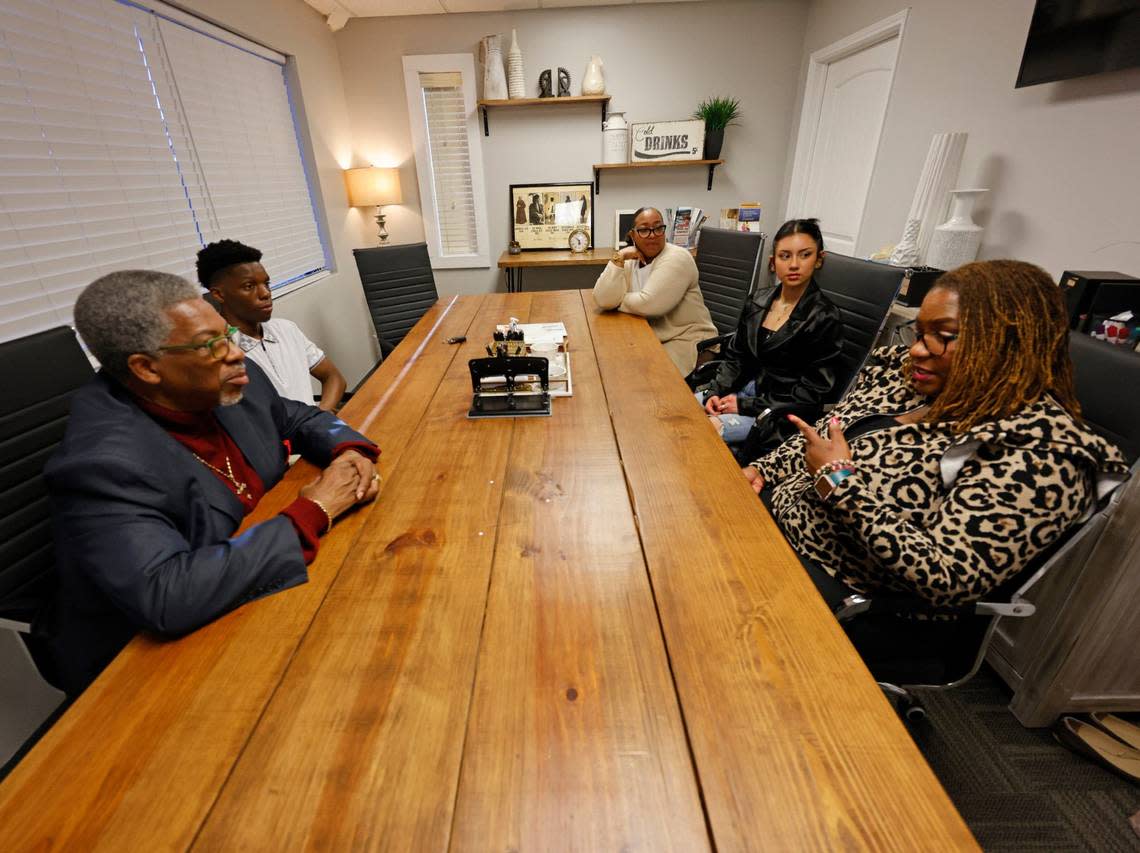‘Robbed of their childhood’ by trauma, these kids get help instead of juvenile detention
Grace, 15, remembers when a judge called her a junkie.
Her lawyer and probation officer told her to keep quiet in the courtroom at the Scott D. Moore Juvenile Justice Center last July, but she couldn’t.
“I didn’t have a reason to do the drugs, but it was all I knew,” Grace told the judge.
That month, she had been charged with a misdemeanor for evading police. She was later tested for drugs and had narcotic painkillers and alcohol in her system. The path that led her to that point began long before her arrest.
She said she was raped when she was 13. Later that year, she overdosed and was sent to a mental hospital. While there, she spent more time working to get out then to get better, she said. She adopted the coping mechanisms of the other patients, meaning she smoked and abused alcohol. She had nothing to look forward to in life and lost herself, she said.
In her mind, she wasn’t a junkie. She didn’t love using drugs — she used them to suppress her pain.
“We don’t realize we have potential because of how bad we’ve been hurt,” Grace said. “We don’t believe in ourselves, and we don’t believe we’re capable of more because of how the world has treated us.”
The Fort Worth Star-Telegram is only identifying Grace and other young people quoted in this story by their first names because of their age. Grace is one of hundreds of juveniles with traumatic experiences in Tarrant County who come in contact with juvenile justice services every year. Some are referred to the Youth Advocate Programs (YAP), Inc. of Tarrant County, which provides alternatives to detention and state incarceration by providing counseling, mentors and community service, helping to reduce the number of repeat offenders.
Alternative to detention or jail
Youth Advocate Programs is a national nonprofit located in 35 states and Washington, D.C., providing trauma-informed services that reduce the nation’s over-reliance on youth incarceration, residential care, and group home foster placements.
Today's top stories:
→ Dad of toddler who died of fentanyl poisoning waited hours to call 911: warrant
→ OU student from North Texas killed in car crash, remembered as ‘cherished friend’
→ DNA analysis IDs remains found almost 40 years ago as missing North Texas woman
🚨Get free alerts when news breaks.
The program offers juvenile justice services, child welfare services, reunification programs, summer school, after-school programs, behavioral health services, and Santa Fe Youth Services, which address substance abuse and anger management.
Tarrant County’s program focuses on juvenile justice and has had a contract with Tarrant County Juvenile Services since 1992. It receives referrals from District Court judges, who handle child welfare and juvenile delinquency cases, or from probation officers. Participants spend two to four months and seven hours minimum a week in the program gaining skills and connections, and once they complete the program they finish the remaining time of their probation.
The program serves juveniles from low-level nonviolent offenders, such as those charged with burglary, to higher-level offenders, such as those charged with aggravated assault. The program is an alternative to incarceration and the youth detention facility, keeping young people safely in their communities.
The Tarrant County program had over 270 referrals last year and averages 200 referrals a year.
Alex Alvear began working with the Youth Advocate Programs in 2016 and worked his way up to the executive director position in December 2023. His wife said he is an example of what the program stands for. He grew up in a single family home with little support, which delayed his graduation from high school. He graduated at 20 years old after a teacher, who never gave up on him, encouraged him along the way.
When finishing his bachelor’s degree in criminal justice at UT Arlington, a professor suggested he apply to the Youth Advocate Programs, where he has been in ever since.
“I wanted to be that person for somebody else,” Alvear said. “Another youth that’s probably going through the same thing as me or just needs that little bit of support or encouragement, or showing that somebody cared.”
The program focuses on the three E’s: economics, education and emotional. The program provides job readiness skills, like learning how to interview and dress, and offers a service that gives participants paid employment training with community partners. Participants can ask for tutors, transportation assistance to school, and wellness checks on their families.
The program offers substance abuse help, volunteer opportunities, and chances to have fun with activities like going to a Dallas Mavericks or Texas Rangers game.
Research by John Jay College of Criminal Justice, located in New York City, found 86 percent of the program’s youth justice participants remain arrest-free, and six to 12 months after completing the program nearly 90 percent of youth served still lived in their communities with less than 5 percent of participants in detention and jail.
Jeremy, 16, is in his second stint in the Youth Advocate Programs. He first came because of an aggravated assault charge, and he is back after stealing a car with friends. He was put on probation and says this time around he wants to stay focused.

Growing up, Jeremy saw the men in his family belong to gangs. His father went to prison, and his mother went to jail. When he was 6, Jeremy and some of his brothers and sisters were separated, and he went to live with his stepfather’s mother in Butler Place, a public housing complex. He and the four younger siblings who went with him slept on the floor with a thin blanket, were treated unfairly and received the bare minimum in care, love and support, he said.
He would sit alone outside on the stairs and stare into the distance to gather himself. Jeremy said he became quiet and heartless.
After a year, his grandmother picked him and his brother up, and they lived on the east side of Fort Worth. They would walk to the south side and steal from houses with his older cousins when he was just 8 years old. It continued as he got older, when he stole electronics and whatever he wanted from stores.
Today, he is thankful to be in the program, to have an advocate, and be around other young people going through the same challenges as him. He has clear goals, such as getting a job, staying in school, and taking care of his family. Even when he has felt life is meaningless, the program has shaped him to want the best for himself.
“I want to be something instead of what the world sees me as,” Jeremy said.
Childhood trauma
Stephen Phillippi is chair of Behavioral & Community Health Sciences at the LSU School of Public Health. He says children of color are disproportionately in contact with the juvenile justice system in comparison to their white counterparts. Even while the number of referrals or arrests may decrease, children of color are still affected at higher rates in many systems, from the child welfare system, to school discipline, or contact with law enforcement.
The Tarrant County Disproportionate Minority Contact Report from 2015-2019 notes that the previous two reports, for 2009-2013 and 2011-2015, showed African American and Hispanic youth were consistently over-represented in the number of overall referrals or those processed within the juvenile justice system through arrests, detention, and petitions, a court document stating a minor committed a unlawful act, in the Tarrant County Juvenile Services.
Between 2015-19 African American and Hispanic youth were referred or petitioned at a significantly higher rate than white youth in the Tarrant County Juvenile Services. In all years reflected in the report, except for 2017, African American and Hispanic youth were arrested at a significantly higher rate than white youth. In all five years, African American juveniles were detained at a significantly higher rate than white youth. Hispanic youth were detained at a significantly higher rate than white youth in 2015 and 2016 but showed no difference in 2017-2019.
African Americans in 2016-2019 were significantly less likely to be diverted, or removed from the juvenile justice processing, than Caucasian youth, according to the report.
Phillippi said children in the juvenile justice system have generally experienced more trauma than the average child. They’ve been traumatized by physical abuse, sexual abuse, neglect, or witnessed violence in their home or neighborhood.
Phillippi says trauma changes the way we react to the world around us and how our brain responds. People become hyper vigilant, reactive, or become indifferent to the consequences of their actions. For children who have experienced trauma, the world becomes unsafe, as everything that is happening to them is outside their control, he said. Children abuse controlled substances to check out of the world, and thoughts of suicide may increase, he said.
“They’re trying to cope, and they don’t have a lot of life experience to try and cope and figure it out,” Phillippi said. “Particularly if they don’t have role models that show them how to cope through these horrible devastating events in their life.”
Mentors provide support
Grace and Jeremy sit quietly in a room as they listen to a Youth Advocate Programs instructor on a Wednesday.
On the whiteboard, the words “Emotional Intelligence” are spelled out in red permanent marker. Underneath, it says, “Who do you want to be rich for?” The room has nine teenagers in it from a variety of neighborhoods in Fort Worth who are seeking a second, third, or fourth chance to fulfill their probation requirements.
Jeremy, dressed in a white shirt, dark blue sweatpants, and white Nike Air Force 1 shoes, raises his hand and says he wants to be rich for his family. Grace, who is wearing a sky blue Champion sweatshirt and jeans, says she would give the money to her mother and donate the rest.
The instructor, V.J. Smith, keeps it simple. “Everyone wants to be rich but rich doesn’t always mean money,” Smith said
Smith has been an advocate in the program for the last five months and works with Jeremy.
Advocates serve as mentors and provide a support network for participants in the program. They connect participants with job opportunities, tutors, and provide emotional support.
Smith has taken Jeremy to meet business professionals, to the library and to sporting events. He has worked with children and families for over 20 years as the former national director of MAD DADS (Men Against Destruction, Defending Against Drugs and Social Disorder), a nonprofit that connects communities with resources.
Ask a young person in the program why they are angry, upset, and defiant toward the world and they will be able to tell you a series of events that led them to that place, Smith said. But they have not been educated on dealing with trauma or grief, so it’s up to the advocates and others in their lives to teach them.
“You’re going to be a part of this program, and they’re going to be some men and women who care enough about you, to want to see you do better, they want to see you change, to want to see your life transform, to want to see you in a better place,” Smith said. “And if you allow them, not only will your life be different, but your goals will be different, your ambition will be different.”
Tyisha Heath has been an advocate for 14 years and previously volunteered to help children at the Boys and Girls Club.

Heath is Grace’s advocate and tells her and other participants she is available 24/7 for them. She helps them with coping skills and with how to regulate their emotions in different situations. She also teaches classes for the program that focus on stress, anger management and hygiene.
The classes Heath and Smith teach help participants because they are among their peers with similar backgrounds in an environment where they are comfortable to express themselves without judgment.
Heath says to “dispose” of children by putting them in detention centers or jails for their mistakes is not the way to help them. They need a loving, caring, and nurturing community to guide them, she said.
“Some of these kids have been robbed of their childhood,” Heath said. “They haven’t really been able to experience a healthy childhood. They’ve been forced to grow up quick, and they’re doing things and operating out of trauma.”
Giving traumatized children a voice
Alvear, the program director, says he has been told by supporters that his program is Tarrant County’s best kept secret, and he envisions the program being more visible. He wants to connect participants with more community worksites to provide them with employment opportunities and expose them more to the community by introducing them to city council members or going to local college events.
He wants to make sure participants are positive and contributing members of their communities and society.
“I want to give my kids a voice,” Alvear said. “I feel it is important that we are able to hear from the youth, so every opportunity that I get for my youth to speak or be a part of something, I’m gonna expose them to that.”
Grace, while still in the program, was arrested again in March for violating her probation and is working to get adjusted again to life and school.

She hopes to return to the program. Grace said she didn’t care about school, or the people who loved her. She was living to die, she said. The Youth Advocate Programs allowed her to be herself, express her emotions, and speak about her pain without judgment and punishment.
“It’s just everything is all bottled up in my mind so you tend to explode and go off on people and don’t have a voice,” Grace said. “So being here has given me a voice, and it’s helped me learn boundaries. I never knew about boundaries, and I never had any guidance.”
After spending a year searching for a job, Jeremy was able to land a position at his apartment complex working with the maintenance crew. He attends program events and classes to improve himself because he doesn’t want to feel the judgment of delinquency in people’s eyes anymore.
“I’m trying to do something good. I’m just trying.” Jeremy said. “So give us a chance. We’re trying, we are doing our best.”
Even as these children in the juvenile justice system grow and make progress they make mistakes, but that doesn’t mean we should give up on them, Phillippi says.
Phillippi emphasizes that the community should care about youth in the juvenile justice system because they need mentors and people who believe in them. We must look deeper and see the traumatic events they have been victims of, he said. Finally, it must be understood that they are teenagers who need development and will come back to their homes, schools, and communities, which must be ready to support them.
“These kids have been victims of lots of stuff in life, to get them to this place where they are,” Phillippi said. “It doesn’t give them an excuse to do their delinquent behavior but it certainly says somewhere along the way, somebody missed the opportunity to intervene and lessen the trauma and toxic stress in this kid’s life.”
